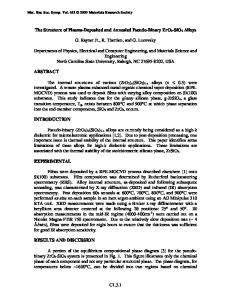Microstructures and electrical resistivities of the RuO 2 electrode on SiO 2 /Si annealed in the oxygen ambient
- PDF / 155,051 Bytes
- 4 Pages / 612 x 792 pts (letter) Page_size
- 83 Downloads / 311 Views
MATERIALS RESEARCH
Welcome
Comments
Help
Microstructures and electrical resistivities of the RuO2 electrode on SiO2ySi annealed in the oxygen ambient Jeong Soo Lee, Hyun Ja Kwon, Young Woo Jeong, Hyun Ha Kim, and Cha Yeon Kim LG Electronics Research Center, 16, Woomyeon-dong, Seocho-gu, Seoul 137-140, Korea (Received 3 November 1995; accepted 15 July 1996)
The electrical resistivity property of RuO2 thin films grown on the SiO2ySi substrate by reactive dc sputtering was examined in terms of microstructure using x-ray diffraction and cross-sectional transmission electron microscopy. As the samples were annealed in the oxygen ambient over the temperature range 300–700 ±C, the resistivity decreased from 270 to 90 mVcm with increasing annealing temperature. When heat treatment was performed below 500 ±C, the strain which accumulated in the RuO2 layer during deposition was released without significant increase in grain size. It is thought that below 500 ±C improvement in the crystallinity plays an important role in the variation of the resistivity. Although a considerable amount of growth of RuO2 grains was achieved, the columnar structure of the RuO2 layer in the as-deposited sample remained unchanged even after annealing at 700 ±C. The resistivity improvement above 500 ±C was driven mainly by the grain boundary annihilation.
In the fabrication of optimum electrode/ferroelectric thin film/electrode capacitors for ultra-large-scale integrated circuits, the electrode materials should satisfy several requirements. First of all, a low electrical resistivity is a prerequisite. As the semiconductor processes are usually conducted at high temperatures in an oxygen-containing environment, the electrodes need to have high thermal stability and good oxidation resistance. Especially, the reactions at the ferroelectric film/electrode and electrode/substrate interfaces which are triggered by oxidation and/or diffusion should be minimized to prevent the formation of undesirable interlayer phases even after high temperature treatments. Good adhesion to the substrates and ferroelectric films is also indispensable. For nonvolatile memory applications, the capacitors require a very high quality polarization fatigue resistance and a low leakage current.1 It was reported that polarization fatigue and leakage current characteristics are greatly influenced by the type of electrode materials.1–3 In addition, the etching process should be applicable in order for the electrode to be compatible to large-scale devices. The PtyTi bilayer has been one of the most extensively studied bottom electrodes because Pt is known to be relatively stable at high temperatures.4–6 However, we have shown that the degree of oxidation increases remarkably when the PtyTi electrode is annealed in the oxygen ambient above 500 ±C.6 The microstructures of PtyTi annealed above 600 ±C underwent drastic changes due to the combined effect of oxidation and interdiffusion. RuO2 , a conductive oxide with the rutile structure, is a highly promising electrode material du
Data Loading...











